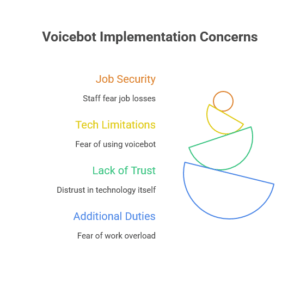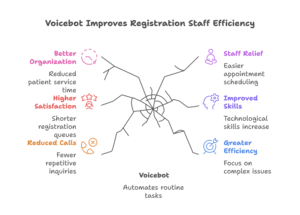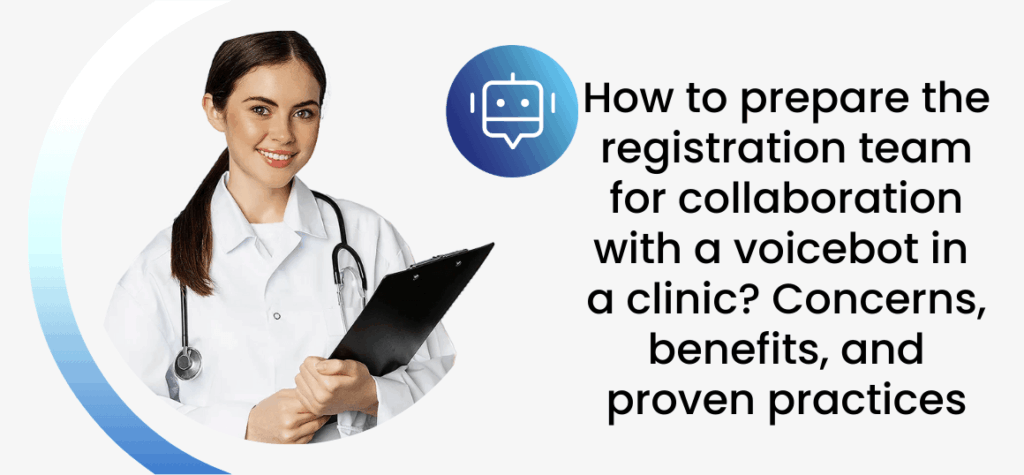How to prepare the registration team for collaboration with a voicebot in a clinic? Concerns, benefits, and proven practices
Preparing the registration team in a medical clinic for the implementation of a voicebot should involve not only learning how to use the tool, but also understanding the benefits associated with it. It is natural that staff may have certain concerns regarding job security or a lack of technological skills. How can this be addressed? Here we present proven practices that will facilitate implementation and properly prepare the registration team for the upcoming changes.
Main concerns of the registration team before implementing a voicebot
Below, in a few sentences, we describe the most common concerns of medical registration staff related to the planned implementation of a voicebot for patient service. It is very important for the clinic manager to thoroughly diagnose the fears of their employees and then skillfully guide the entire implementation process.

Are staff afraid of losing their jobs?
One of the primary concerns is the fear of job loss. The registration team worries that a medical voicebot might replace human work. In principle, however, it serves only as valuable support, and at this stage, electronic patient registration cannot fully replace the role of a human registrar. Many people still prefer personal contact at the clinic, and some more complex issues require staff involvement.
Technological limitations and fear of using the tool
Many people worry that they will not be able to properly operate the new tool. Technology often causes anxiety linked to limited skills. That is why it is very important to carefully plan the implementation process and devote plenty of time to staff training. Today, AI voicebots have become a common solution in healthcare facilities and are designed to be easy to use. This reduces the risk of potential errors and ensures that even older staff members can handle the tool. The key here is education and support in overcoming technological fear.
Lack of trust in technology
Another factor influencing reluctance to implement a voicebot is a lack of trust in technology. Registration staff often point out that an AI tool lacks emotions and empathy, which may limit its ability to fully understand patients and handle complex issues. This is precisely why voicebots take over only the basic processes related to patient registration, data verification, and answering frequently asked questions. More complex cases are managed by medical staff, and it is crucial to make them aware of this division. In this way, the risk of errors is reduced, and employee concerns are alleviated.
Fear of additional duties and work overload
The transition period associated with introducing electronic patient registration or another system in the clinic often creates additional tasks. This is connected with the need to learn how to operate the tool while continuing regular responsibilities. Many people tend to avoid extra duties, justifying it with a lack of time. However, it is important to make the staff aware of the purpose of the change and the benefits it will bring. A bit more work now will make the job easier and more enjoyable in the future.
What benefits does a medical voicebot bring to registration staff?
The implementation of a medical voicebot in patient registration allows staff to focus on solving the most important issues and better organize their work. They no longer have to respond to the simplest inquiries, and the burden of registering large numbers of patients is taken off their shoulders. A significant part of this process is handled by the tool, which shortens phone queues and increases patient satisfaction with the services provided by the clinic. As a result, conversations with medical registrars become more pleasant, improving overall working conditions.
The main benefits experienced by registration staff after the implementation of a voicebot include:
- a reduction in repetitive calls and elimination of routine work,
- improved conversation quality and higher patient satisfaction thanks to shorter registration queues,
- better work organization and reduced patient service time,
- relief for registration staff throughout the appointment scheduling process,
- improved technological skills among registration team members,
- the ability to focus on the most important and complex issues, leading to greater daily work efficiency.

These arguments for implementing a voicebot in the electronic patient registration process should be thoroughly discussed with the team. This will help to dispel many basic concerns and make the implementation of the new tool smoother. One common mistake made by medical facility managers is to approach implementation without prior preparation of the team. It is advisable first to present the advantages and applications of a medical voicebot and then skillfully plan the entire process.
Proven practices for implementing a voicebot in a medical facility
Below we describe proven practices that facilitate the implementation of a voicebot in a clinic. These are based primarily on clear communication and the active involvement of the registration team throughout the process.
Team education before implementation
Even before the implementation work begins, the team should be educated about the technological changes affecting medical facilities. The goal is to build awareness within the clinic of the necessity of using modern technologies and the benefits they bring. This stage should also focus on addressing any questions or concerns employees may have. As part of the training, it is helpful to highlight facts and myths about artificial intelligence in healthcare to avoid misunderstandings.
Informing the team and patients about ongoing changes
During implementation, it is important to focus on clear and straightforward communication. Every team member should have up-to-date information about the current status and what is happening in the clinic. Communication should also include informing patients about the changes being introduced. For this purpose, social media, posters, and on-site notices are commonly used. This makes it easier for patients to go through the transition period and increases their understanding. It also has a positive impact on the image of the medical facility and facilitates service delivery.
Training the team on how to use the tool
At the implementation stage, the team should undergo training on how to operate the tool. A standard solution is workshops conducted by representatives of the tool provider. Every registration staff member should have detailed instructions on how to use all the features necessary in daily work, as well as procedures for handling possible errors or system failures and switching back to traditional registration if needed. The training stage also includes conducting simulated conversations with the bot to better understand the tool and its specifics.
Dividing implementation into stages
The entire implementation process should be divided into stages. This ensures that knowledge is delivered to the team in manageable portions. Overloading employees with all the information at once may have negative effects. It often overwhelms the team, making them feel helpless and unable to understand the tool. This is why it is best to introduce the voicebot step by step, verifying the team’s response after each stage and clarifying any doubts. A proven practice is to start with basic functions (e.g., appointment confirmations) and gradually expand the tool’s functionalities.
Collecting feedback from the team
Since the registration team uses the voicebot on a daily basis, it is essential to regularly collect their feedback. This should cover both the strengths and weaknesses of the tool. Gathering this input allows for adjustments in patient service processes and helps improve the quality of services while simultaneously increasing the comfort of work for medical registration staff.
Confirming the benefits through report results
How can you convince the team to embrace the voicebot? After a few weeks of use, it is worth organizing a summary meeting. During this meeting, you can present the report results, which should highlight improvements in patient satisfaction as well as the number of cases handled automatically by the voicebot without the involvement of registration staff. This clearly illustrates the benefits of implementing the tool, including time savings and better work organization. It will help encourage employees to actively and willingly use the functionalities of the medical voicebot, as well as any other system introduced in the facility.
Join our medical sector clients
At EasyCall, we have extensive experience in implementing medical voicebots in clinics. We fully understand the needs of managers as well as the concerns of employees. We address these by preparing a tailored implementation schedule and adapting the tool to the actual needs and capabilities of the facility. Get in touch with our expert, who will guide you through the process.
Don’t wait—join the growing group of our medical sector clients, which already includes institutions such as the District Hospital in Rawicz, Medica Kielce, Omega Medical Clinics, and many others. Discover all the success stories of our clients in the medical field.



